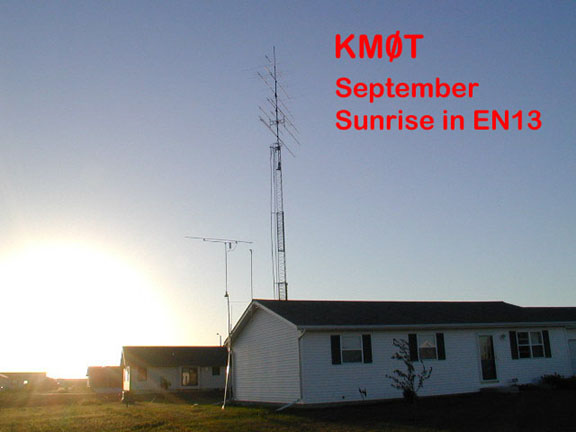
KMØT September 2000 VHF Contest Synopsis and get on 2304 in a Week!
I can recall about 2 or 3 weeks before the September contest my wife asking if I could help her with the city wide garage sale. I asked her when it was and as it turned out, it was on the Saturday morning of the September contest. I indicated to her that it would be no problem because I really had no station improvements to make. I was ready to go and I could help her out in the morning before 1:00 PM local. She seemed very happy and went about her business. As usual, I really had no idea that my sub-conscience was working overtime…
Ideas Brewing:
I was not long after that when I read an email about some crazy dudes that were going to be roving from the Fargo area on their way back to Texas. Something about dropping a kid off at college and just happening to be in the area. They said that they would have a lot of bands, so I figured it would be kinda neat to catch them in a few grids. A few more days went by and I just forgot about it as I helped my wife carry junk into the garage for the upcoming sale.
This was about the time that I was considering having my own garage sale. There was a hamfest scheduled for the end of September in Sioux Falls, I had a bunch of junk laying around and decided to start putting together a list of the excess ham gear.
One item in particular was a dual band FM rig. A Yaesu FT-8100R which had been gathering dust. When I got into weak signal stuff, the FM rig just sat there. FM contacts during contests around here are few and far between. I tried it during one contest, hardly worth the effort not being in a metro area. I really did not want to get rid of it, but all I could think of was the cash and what I could get that was usable. I would use the 2M FM once in a while, but for a contest? My concentration was broken as I was summoned to move an old couch into the garage.
1.5 weeks before the contest, I'm still not thinking that there is anything to do in terms of station improvements. The bands had been hopping quite a bit, 902 and 1296 contacts were getting out there. My buddy Gene, NØDQS in EN22 and I were cleaning up on 2M as well, some new grids here and there. So during one of the lulls in the opening, we were discussing Gene's upcoming rove for the contest. We were chatting about the grids, routes, etc.
What? FM!!!?:
Just for fun, I had always been riding Gene to get on more bands, simply because in all the previous contests I had worked him in on all the grids he activated. He normally laughed at me and said "someday".
It was that night as my wife was indicating the position of a table to be moved - it came to me……..trade the 8100R, get that Kenwood 1296 FM rig, give it to Gene for the contest with your spare 35 element 10' 1296 yagi….Hmmmm – this made sense to me!
I knew it would work, just the night before I had worked Dan in Illinois, KA9WBT in EN62, 400 some miles away on 1296. He did not have SSB yet, but wanted to give it shot. So we QSYed up to 1296.200 and I worked him on FM no problem. I even turned my power down to less than 1 watt and he was copying me just fine. This event I believe is what started my gears turning in my head as I hit the sack.
The next night I pitched it to NØDQS. I told him "boy did I have a deal for him" Gene seemed to be up for it so I proceeded to look on the net for that Kenwood 1296 FM rig. The reason we were thinking of FM was because of its simplicity. With the short time left before the contest, I was not in the mood to figure up a transverter and integrate it into Gene's mobile system, I just knew this was not an option. Keeping it simple was key, at least for now. Commercial CW and SSB 1296 equipment is next to impossible to find and a 736R is not a real compact mobile rig.
23 'oh' What?
It was about this time I remembered that I needed to dig up that email about those guys who were going to be roving till they puked. I could not find it so NØDQS forwarded it on to me. That night I reviewed it with great interest….all those grids and coming right by my place, goody for me! I remember thinking…"This will be great for 1296 and 902, too bad I don't have 2304, those grids probably wont be activated for quite some time" Well wait a minute, why don't I have 2304?
I remember thinking to myself, "according to Bruce, W9FZ, he thinks I'm on 2304". When he stood up to nominate me as a member of the Central States VHF Society committee at the conference in July, he indicated to the crowd that I had recently gotten on 2304. I remember chatting with him before about being interested in getting on, but was not sure when. When he said that, I turned to Jon, WØZQ who was also at the conference in Winnipeg…"I guess I better get some 2304 stuff" He just laughed!
Central States VHF Conference - 2001 Dallas, Texas
I started looking around and investigating 2304 equipment and antennas. With a little over a week before the contest, I had to move quick…It would be a shame to let those crazy rovers out of the area without a 2304 qso. I knew I could not get a kit built that quick so I checked with Gerry at SSB Electronics and as a starter system, it looked like the DB6NT 1.5 watt transverter was the ticket. Called David at Directive Systems and got a 76 element looper coming. I asked him to build and test it as I had nothing to measure power and SWR at 2304. This was right before some microwave conference out east that both were to attend, so I was not able to get the stuff as quick as I could.
After some investigation, I knew I needed to put the transverter in some kind of weather proof enclosure and mast mount the unit at the antenna. That way I could take advantage of all the power the transverter could muster. Also no worry about sequencing and receive preamps. So for the next few nights, I racked my brain about how to enclose this piece of equipment that I had never seen before.
Might as well go for it!
It was shortly thereafter that I thought to myself as I was sweeping the garage….If Gene can do the 1296 FM thing with my yagi, why not get one of those 2M, 222, 1296 tribanders…just get a HO loop for 222, no big deal, trade the 8100R and some other junk….hey that makes sense!!! I think I called NØDQS on the landline about this one. Gene seemed to be all for it so I proceeded to go after the gear.
Help from EN26:
A few days later things started to come together, all except no interconnect cables and fittings for the transverter. Without ever having any high band stuff before, I had no idea what I needed, I had never even seen a SMA connector before. So I took a chance at ordering some stuff from RF Connection. They were pretty helpful and I thought I had it all worked out in my head on what I needed. As it turned out, later in the week I needed to get a few last items. Also, Jim, KØMHC/Ø in EN26 explained some ins and out to me on 2304 stuff and sent me a few cables and fittings. This helped out immensely.
Testing the FM Equipment:
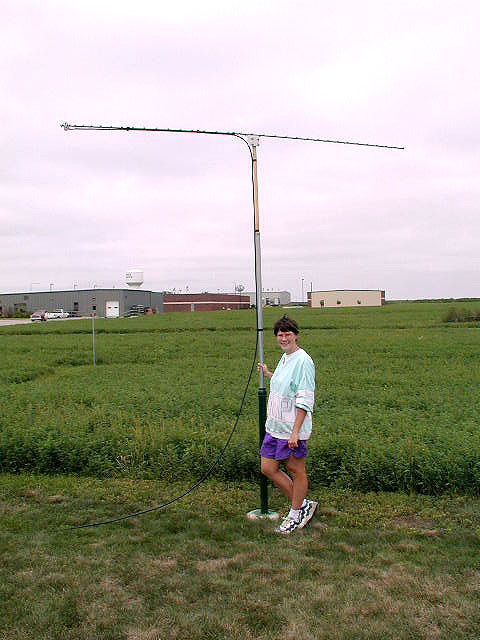
On the Saturday before the contest, I had the new Kenwood tribander in hand. I set up my 1296 yagi on my trusty test mast and connected it up for a test. I also assembled the 222 Mhz M2 loop and stuck it on a chunk of sheet metal on a ladder. That 222 loop was tuned perfectly on the first assembly per the instructions, I could not believe it. I had had trouble on 144 and 432 loops before, some adjustment always seemed needed. Not on 222 however.
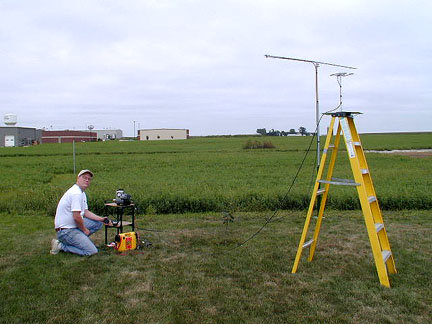
(As an aside…Interestingly enough I have had the same exact experience with my 144, 222 and 432 yagis from M2. The 144 and 432 always needed tuning after instruction assembly. The 222-5WL worked right off the bat and had a great bandwidth as well….hmmm)
Gene showed up with the rover mobile and I had the pleasure to tell him that the 1296 and 222 stuff was working great. I had field tested the both the band modules and had good power and very little reflected power on both antennas. We quickly set things up in the truck and tested them there as well. Things looked good and we proceeded to testing a bit for some 2M and 432 gremlins he was having. He got those all worked out just in time for the contest. I worked Gene on 223.5 FM with no problems on his way home. Things were looking up!
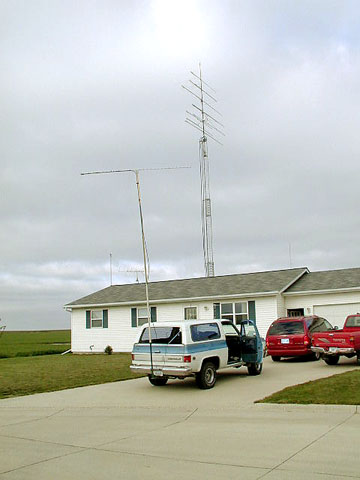
I should Have taken 'Metal Shop':
Sometime that same day, I picked up a 'mapp' gas tank and brazing torch. I had looked at all kinds of boxes to put the 2304 transverter inside, but nothing seemed to fit the bill. Everything was too big and bulky. Also weight was a concern. Now that I had the transverter, I knew what size I needed. So I proceeded to make my own box with some ductwork sheet metal parts, a brazing tourch and 'stepper' bit for drilling holes. I still did not have the looper, so I was not sure how the transverter box was going to mount on the antenna frame, but I needed to proceed, time was running out.
The geometry of the transverter poses some definite challenges in terms of weighing all your options. One can try to have hard connectors from the transverter inputs and outputs, but then how does one tighten the connectors from within. That would all be no problem if you had a weathertight cover, but I went for the sleeve approach and two interconnecting cables to the outside world.
The transverter is attached to a piece of sheet metal framing that holds the input and output N connectors. The power connector also is attached here as well. Essentially this "mounting frame" slides within the outside cover. The outside cover has a few bolts out of the top for attaching to the looper sub-boom.
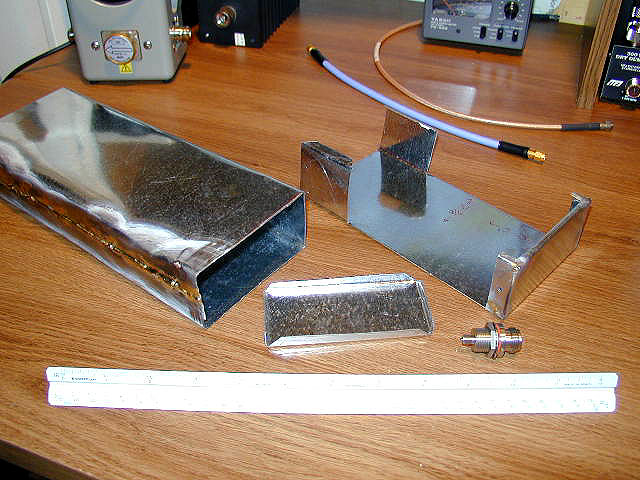
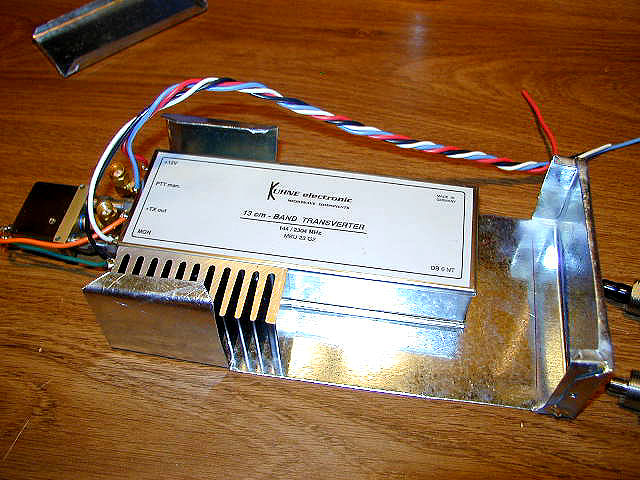
The looper came in via UPS on Wednesday before the contest. I assemble the boom parts and sub-boom over my lunch break. I ordered the unit assembled and tested by David at Directive systems simply because I had nothing really to test the unit out with. I wanted to be sure that the feed system was working, that was one headache I did not need. Anyway, I left the looper laying in the garage after lunch near the door. Later that day I had to pick up my daughter Patricia from daycare. When she walked in the door, she saw the new looper. She walked up to it and touched one of the little loops, looked at me and said 'baby tenna' All I could do was laugh and feel real proud of her J
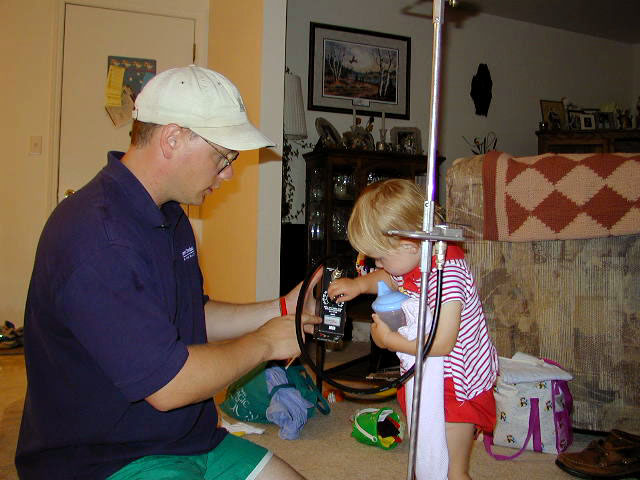
About that time Gene got out on road and tested the rover stuff for 1296. All seemed to be working for him in his rover setup.
Some technical aspecs of the 2304 transveter and setup:
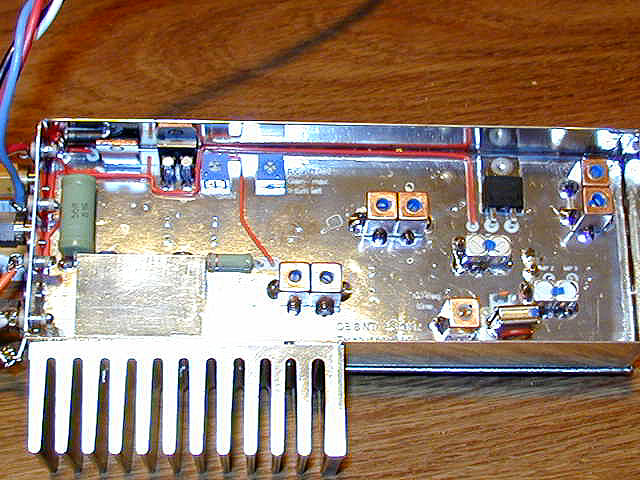
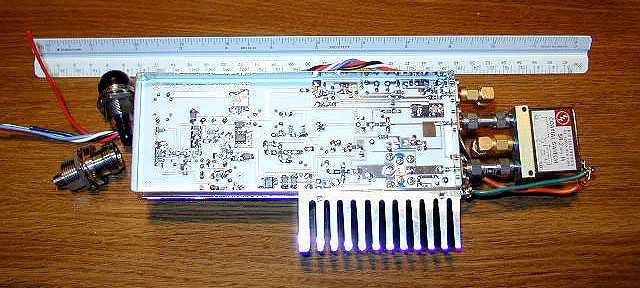
The unit aparently is capable of greater than 1 watt. Can take up to 3 watts drive. It has tx/rx input switching at the IF of 144. It has separate tx and rx ports on the 2304 side, therefore an external relay is needed. All connectors are SMA type.
The SMA relay I chose was a 12 volt unit from SSB Electronics, Mil Spec. This relay is aparently rated to 50 watts at 10 GHZ. Now I know why everyone likes 28 volt Transco relays. The 12v relay was pretty expensive. The transveter happens to have +12 output for external relay control, so this was extreamly convienent. I was not into figuring a 12v to 28 volt conversion or rewinding a 28 volt relay at this point. Maybe someday in the future I will tackel this. I used male to male SMA connectors to connect the relay to the transveter, the TX and RX SMA connectors on the transveter are spaced perfectly to use the male to make SMA connectors.
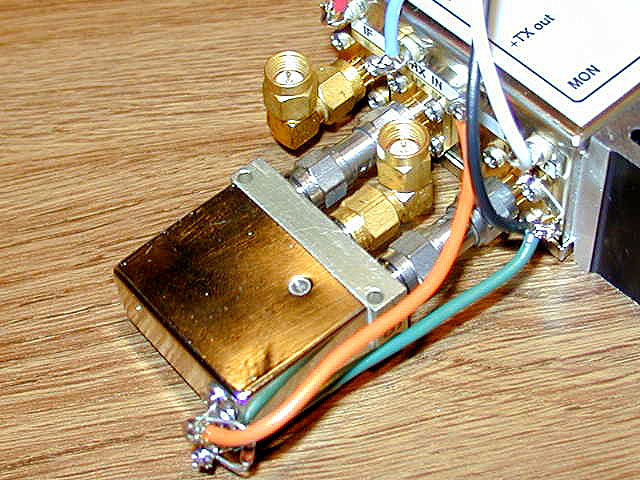
One thing I had in my mind was that the output of the relay would be on the other side of the relay from the inputs, why I though this I do not know, but it caused me headaches not having any 90 degree SMA elbows around. A very 'newbie' mistake on my part and a source of frustration on the design I had in mind for my transverter box. This is where Jim's (KØMHC/Ø) parts came in handy to save the day.
Also, with the relay configured as it was, then I was married to having to cable the input and output of the whole unit to the outside world. I ordered a few SMA to N bulkhead connectors and located them at the bottom of the transverter sheet metal frame. Then I had to use the SMA cable I ordered from RF Connection and one that KØMHC/Ø sent me. I had never really worked with any of these kind of cables, and came to find out that they were pretty stiff and one needed to take into consideration the bending radius, etc. Food for thought if you are going to do something like this.

As you can see, I put nail polish on the SMA connector threads. This was suggested to me by Gerry at SSB electronics. Also, he told me to put a regular diode across the relay power connection to keep relay release voltage from getting back into the system. I would have never thought of this myself, good thing he reminded me. Relay Inductors release energy apon de-energization, it has to go somewhere. The diode conducts this high voltage release spike to ground. Another disaster averted. Jim, KØMHC/Ø indicated to me that I needed to put a .01 UF across the power leads right where they enter the transverter enclosure. I did this but I cant remember why he told me to do it. Possilby RF voltage induced on the power leads from a varying SSB or CW signal doing something? Can someone can give me the specific info on this, thanks.

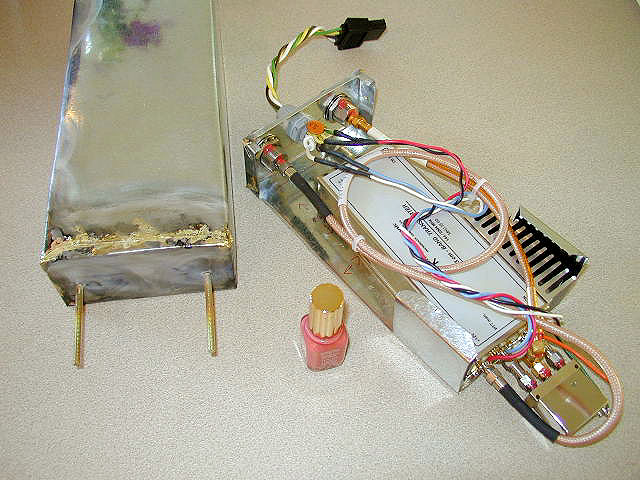
As the IF, I am using a Yaesu FT-100D. At 144.1 Mhz, FM or CW keydown the unit puts out roughly 47.5 watts with its output menu item set to 100. The 144 Mhz output menu can be set to any value from zero to 100. At the zero setting, the FT100D put out a little over 3 watts. According to the transverter specifications, the unit can take up to 3 watts of drive. I spoke to Gerry at SSB electronics about this and he indicated I would want much less drive to give myself some room.
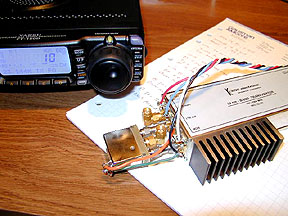
How can a resistor cost that much?:
I began to look into attenuators, with 5 watt ratings, 3 and 6 db of attenuation. Man are those things expensive. There are a few resources, but if one was to check around, the best resource seemed to be 'ebay' if you could find what you wanted within the proper time frame. I spoke with Tom, WA8WZG and he had a few attenuators at very good prices, but he too went to the some microwave conference the week before the contest, so the timing was not good for getting them in time. I also looked at some comercial attenuators from Bird, but they were big bucks.
I decided to use a coax attenuator, about 100 feet of LMR-240 to be exact. I just happened to have a 100 feet laying around that I was going to use for jumpers and misc mobile cabling. I never did use it for that so I put some connectors on the entire roll and connected it to the FT100D and a dummy load and a Bird meter. At 144.1 Mhz, LMR-240 has a 2.953 db loss per 100 feet. (using the cable calculator on the Times Microwave Website. The mesured load at the end of the cable with 47.5 watts in was 22 watts. (144 Mhz power menu set to 100) The reflected power was less than a half a watt. This gave a calculated VSWR of 1.23 to 1. These number plugged into some Java program I found on the internet predicted 22.35 watts at the dummy load. Good enough for me! Just proves that 100' of LMR-240 is a 3 db attenuator at 2 Meters. With the 144 power menu set to zero, the FT-100D puts out 3 watts. With the 100 feet of cable in line, 1.5 watts was mesured and confirmed my calculations and expectations. Now I had some room to adjust the drive level to the transverter.
Late Wedneday night I decided to put power to the transverter and giver it a go into a dummy load. I did not have anything to mesure power with at 2.3 Ghz, so I used my Bird meter with a 50 watt slug that was rated to 1800 Mhz. I figured a relative reading was good enough to be sure I was getting output. Also as a feature of the DB6NT tranverter, there is a 'monitor out' line that produces a relative DC voltage in relation to ground depending on power output.
Incidently, all units were being run at 14.1 to 14.2 volts DC. I used a 70 foot roll of 6#16 conductor rotor cable for the PTT control, power lines and the monitor line. The transverter draws very little current, so #16 was appropriate. Plus its what I had laying around!
Somewhere around this time I got an email back from the ND2X/R team. I had sent an email out to them in response to looking for who was going to be around for the long Saturady night / Sunday morning. They were definely going to be looking for me and I had let them know that the 2304 stuff was looking up and quite probable for the contest.
Testing the 2304 Stuff:
I connected everything up with all the cables in the shack and to the dummy load. Applied power to the transverter and heard a good roar of hiss much louder than the FT-100D itself indicating the RX gain in the transverter. The transverter unit has 20 db of RX gain and is adjustable. For what I heard in the RX, seeing that the S-Meter did not move, I decided to leave the RX gain as is.
(Actually, the spec sheet that came with the unit had an actual mesured RX gain and noise figure, signed by DB6NT himself – The spec sheet indicatedt that the RX gain was over 20 db, noise figure was about .68 db and the power out was 1.43 watts with 2.5 in.)
I then proceeded to analyse the monitor out voltage. After about 5 to 10 minutes of warm up, putting the FT-100D and transverter into PTT produced a fairly constant voltage in the milivolt range. When I keyed a constant tone (CW) then I got 2+ volts. I also saw around 1 watt on the Bird. Gerry at SSB electronics told me once I had the drive level set, go in and adjust the attenuator inside the transveter so that you could see full output. I went through this process until I could see no more deflection on the Bird wattmeter. I also watched the montor voltage out. I then adjusted beyond full output and saw the monitor voltage go up slightly, but no more visible additional wattage on the Bird. I then adjusted the attenuator back to where the output just stopped going up in relation to the monitor voltage being less than when no attenuation was present. All this being done with having full output, but trying not to overdrive the unit. I seemed to find my compromise settings and saw that a consistant reading of 2.84 volts was being displayed on my VOM during CW keydown. The Bird was showing about 2.5 watts now, but I did not give that reading a whole lot of attention since the slug was not in the frequncy range, the slug power rating was too high and the device at best is 5% accuarate anyway. I marked my readings all down and hit the hay. Things seemed to be working appropriatly.
Two days to go:
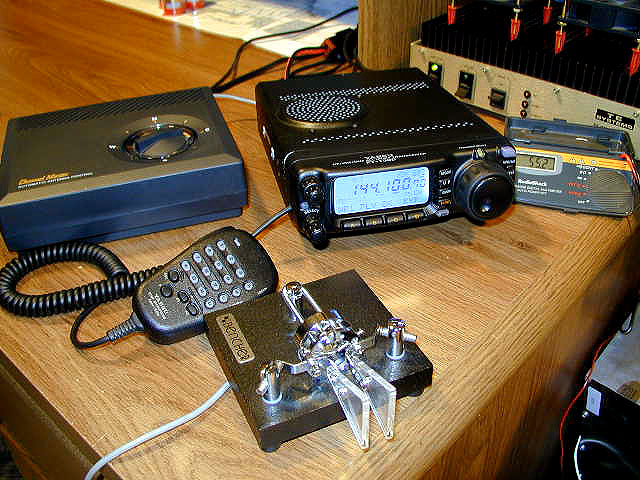
Thursday before the contest I got the looper installed on my test mast with a 1" aluminum conduit. I then looked at where to mount the transverter in accordance with the LMR400 interconnect cable length. I had David at Directive Systems make a 50 inch cable with N connectors. The reason I had David make the cable is because I had no accurate way to determine if I made the connections good for 2.4 Ghz. David swept the finished cable with his equipment to verify that the return loss / SWR was very good. That eliminated just one less thing that I did not need to worry about. With the length of the cable, the transverter mounts where shown without too sharp of bends. It would have been nicer to have the transverter closer to the mast or a bit lower out of the aperture of the antenna, but the location was a compromise between cable loss, loss of gain being in the aperture slightly and not knowing what I was doing J I basically put it together as best as I could using the best info I could come up with in a short time frame. Once the transverter was mounted, I determined the balance point and moved the mast plate back one width. I only had to drill one hole to move the plate back.
With transverter mounted permanently, I proceeded to connect the power/control cables and the LMR-240 IF cable. I then took a can of some rubber weatherproofing and brushed it on the connectors and seams of the transverter enclosure. The bottom of the enclosure has a weep hole and seam openings so condensation has a chance to evaporate.
A quick trip in the shack confirmed that all was well. The RX gain noise was present on power up. After a bit of warm up time, I applied drive and was surprised to see the voltage on the monitor line showing over 3 volts. I deduced that the looper had a better match than the dummy load I was using before thus allowing more output? Good enough for me, so I dragged the unit up on the roof and attached it to my TV mast rotator. The whole assembly puts the looper about 27'. I really wanted to get the unit up on the tower, but I just did not have time to think of a good location for the new looper.
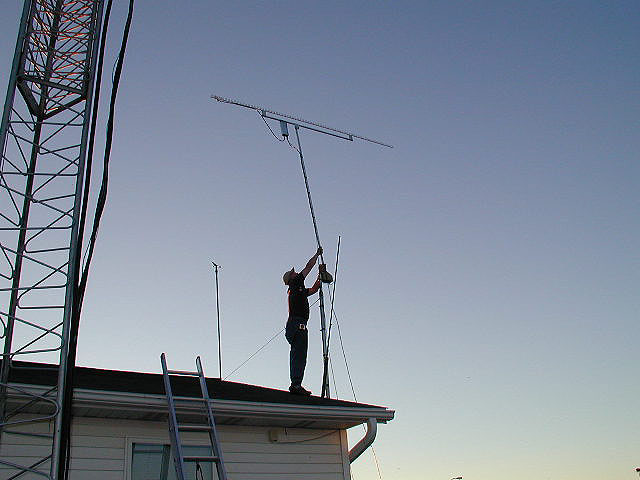
All was ready for the contest, with one night to spare. I had to be done on Thursday night, I had my company picnic Friday night and I had to cook steaks for my employees. We all had a good time, drank a few beers and I had a chance to forget about all the madness I went through in the previous week.
I talked to Jim, KØMHC/Ø for a brief time on later Friday night. He indicated that the ND2X/R team was staying there for the night getting ready for their monster roving effort back to Texas.
The Contest:
I woke up early Saturday to help my wife with the Garage sale, my head was a bit foggy from the festivities of the pervious night. The wind started to pick up, which was a bad sign as far as I was concerned, blowing potential tropo enhancement out the window.
The contest began and the conditions were not good. Worked a few locals and tried 6M, very dead there too. Just worked everyone I could hear.
Picked up N0DQS/R in a bunch of grids, the 222 and 1296 FM stuff was working! The points were starting to help out. Caught K9AKS/R in DN90 out west on 222 for a nice one early on. About 45 minutes into the contest I caught ND2X/R in EN26 on 144. Then right after that in EN16 ion 144, 222 and 432. This rover stuff was working out! That was around 1900 UTC, I did not hear from the ND2X/R team for another 9 hours or so, 0400 UTC, late that night. Apparently they were having truck problems. In the meantime I followed Gene, NØDQS/R around and had fun picking him up on FM.
Around 2300 I ran into KØMHC/Ø. We worked on most the bands but had trouble on the high bands, possible equipment problems on his end. The highlight was that I could hear his 2304 signal no problem, wow could that little looper 'hear' Jim unfortunately could not hear me, but I was happy to know that at least 'half' of my 2304 station was working. EN26 is not just next door either with marginal conditions.
Later on I had one of my last qsos of the night with NØDQS/R and started to hunt down ND2X/R again. As I previously mentioned, I was able to hook up with them again around 0400. They where in EN05, coming down my way pretty close. I worked with Marc from the NØQJM Muli-OP (Holly's contest station J ) and started tracking Paul and Ken as they traversed the grids. I was able to get them on all the bands (including 902 and 1296) in EN05, 04 and 14 except 6M and 2304. (They were having 6M antenna problems)
About 0600 I had the last qso with NØDQS/R in DN92. Gene and his son were getting ready to call it a day, starting out early again in the morning. In the mean time, while waiting for ND2X/R to get into the next grid, I spent quite abit of time talking to Marc – WBØTEM. He discussed a lot about his 10 Ghz and moonbounce equipment. It was neat to hear about the stuff I would like to be doing someday. It made the night go quick since the bands were really dead except for ND2X/R and the occasion meteor scatter qso in 6M.
Around 0630, I linked up with Matt, KFØQ (formally KFØUK) He was doing a multi-op this year over in EN44. I heard him on 2304 but he was not hearing me, hmmm frustrating. We set sched for the next day to try again.
I was also able to chat with Paul, ND2X himself. Paul was not doing much of the operating except on 1296, where we got a few minutes to learn about each others station and what prompted us to do in ham radio what we were currently doing. It was nice to be able to take some time to meet the guys.
It was at 0730 when it all came together. I had worked ND2X/R on all the bands in EN14 except 2304. They said they would stop at the grid line of EN14 and EN13 to get a bit closer to try 2304, and low and behold it worked! And on SSB I might add! The rig sounded great and got a good report back. I also worked them in EN13 and EN12 on 2304. Also, they were nice enough to stop when they were due west of me, the closest distance between us. They stopped on the highway and we had a few minutes to ragchew on 2304, I got to swing my looper back and forth to get a feel for the beamwidth. I also got to send them some CW and have them give a critical assessment of the signal quality. All reports were fine business, no drift, chirps and FB audio. Their signal on 2304 sounded very good as well. I was extremely pleased with my first 2304 qsos!
I was able to work them on the other bands thru EN20, then kinda lost track until EM29 at 1430 hours on 144 an 222 only. That was about it from them, the conditions were not good at that point and the noise levels were rising. I think I snuck a 30 minute nap in there in the early morning. I think that is why I probably lost track of the ND2X/R team.
At 1330 or so I was able to work Paul WØUC on 2304. That was great, EN44 on 2304!
K9AKS/R was in DN92 and DN93, got him on 222 and 432. Gary WAØBWE was on around 1445, got him on all the bands except 2304, did hear him well however. We tried a few more times, but were never able to make it.
NØDQS/R woke up and started making contacts, I caught up with him around 1530 in DN93 and DN92. We are not able to make it on FM on 222 and 1296. That was the bummer of the morning. When he got closer in the other grids, we again had no problem. Conditions were not too hot.
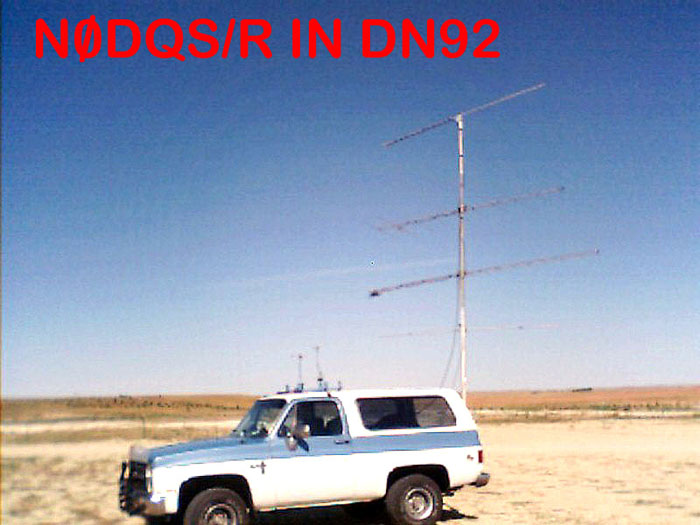
I chased KB9C/R around a bunch of grids in the afternoon, was able to complete a 2304 qso with him at 2000 UTC. Thanks to the NØUK Multi-op for letting me know he was around!
I had been looking for Tim - KØPG/R and Pat – KB9WVL/R all weekend, apparently some weather issues changed their roving plans. I heard them around 2130 and we got to work in a few grids on some of the bands. It was nice to make my first qsos with Pat, as she was just recently licensed and already doing the contest thing. Congratulations Pat!
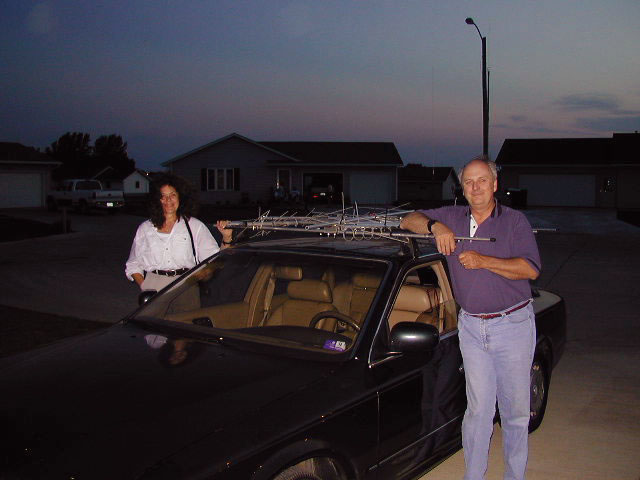
At 0152, I finally completed with Matt- KFØQ in EN44 on 2304, thanks Matt! You had good signals down here. Wow that looper can hear!
As usually, the contest ended with lots of mayhem on144.200. Many folks scrambling to make qsos, I myself included. I always seem to run into Lee - KCØBZE and Chuck – KØSQ, towards the end of things to make 1296 qsos. Thanks guys for looking for me! The contest ended with the band starting to open to the south and south east. That was a bummer. 6M was dead all weekend. No AU was heard at all, not like last year.
SUMMARY:
|
BAND |
QSOS |
PTS/QSO |
QSO POINTS |
MULT–GRIDS |
|
50 MHZ |
36 |
1 |
36 |
22 |
|
144 MHZ |
92 |
1 |
92 |
42 |
|
222 MHZ |
49 |
2 |
98 |
30 |
|
432 MHZ |
57 |
2 |
114 |
29 |
|
902 MHZ |
17 |
3 |
51 |
15 |
|
1296 MHZ |
29 |
3 |
87 |
19 |
|
2304 MHZ |
6 |
4 |
24 |
5 |
|
ALL BANDS |
286 |
502 |
162 |
KMØT Claimed Score: 81324
Thanks to all the Rovers! Without you my score could not be anywhere close to what it is.
Rover Summary:
|
BAND |
ND2X/R |
NØDQS/R |
KB9C/R |
KØPG/R |
KB9WVL/R |
K9AKS/R |
|
50 MHZ |
2 |
5 |
1 |
0 |
0 |
0 |
|
144 MHZ |
12 |
11 |
4 |
2 |
2 |
0 |
|
222 MHZ |
11 |
9 |
3 |
2 |
2 |
3 |
|
432 MHZ |
10 |
11 |
3 |
2 |
2 |
2 |
|
902 MHZ |
8 |
0 |
3 |
0 |
0 |
0 |
|
1296 MHZ |
8 |
9 |
3 |
0 |
0 |
0 |
|
2304 MHZ |
3 |
0 |
1 |
0 |
0 |
0 |
|
Total Qsos |
54 |
45 |
18 |
6 |
6 |
5 |
|
Total Grids |
12 |
11 |
4 |
2 |
2 |
3 |
Total Rover Qsos = 137
Rover Qsos % of Total Qsos = 48% WOW! Who says rovers are not necessary?
I give my hat to all the rovers, especially ND2X and NØDQS. I think that Gene had a good time running with the 222 and 1296 bands, even if they were FM. I believe he even worked some more folks on 222 FM other than myself. I think he may be thinking of adding some bands in the future!!! If I ever get down to San Antonio, I will definitely look up Paul and Ken. Maybe I will see them at the Central States VHF Society Conference that is being held in Dallas in 2001. Also, hope to catch Tim and Pat next time in a few more grids, you were very much missed over here!
That's about it from here, thanks all for the qsos, I enjoyed it. See you in the next test. All I need now is more power on 2304 and thinking of adding 10 GHZ for next summers contests. Any rovers out there going to be hanging in my area on those bands? Hope so! Thanks for reading. Oh yes, we made $80 in the garage sale…errr…or should I say she made $80.
73 – Mike – KMØT en13vc